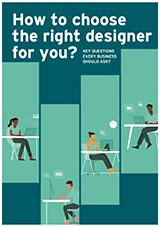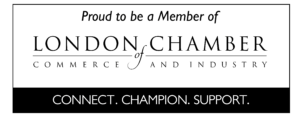Corporate Design: What is that all about?
What do you think of when someone talks about corporate design. Most often people seem to think of graphic design, but good corporate design also embraces design strategy, and brand architecture too.
This means that in modern usage corporate design is not just concerned with the graphical identity and visual representation but also the structure and planning of particular processes to achieve distinct goals.
Most larger corporations have understood this for many years and have incorporated every form of design into their success strategies.
For effective corporate design, it’s important to define the two common strands that corporate design covers – which I will then expand on so you can apply the theory to your own company.
- Corporate identity design, as it’s most commonly understood, is a visual representation of the company (logo, typography, colour schemes); the identity and
- Corporate strategy design (brand, structures, values, culture, quality, community, etc)
So let’s look at the elements of an effective Corporate design.
1. Logo
The logo is akin to a badge. That’s what a brand mark originally was after all. A hot metal brand burnt onto the rump of cattle, whiskey barrels and packing cases. Those burnt marks carried a 3 fold meaning:
- Ownership
- Quality (if the brand has established value with the audience)
- Authenticity (like the seals used in days of old when the gentry had emblems they would use on wax seals to denote the provenance of a letter or agreement of a contract).
The modern company logo is simply the updated version of that ‘branded’ mark. It is a representation of the company and acts as the ‘face’ of your organisation. In terms of branding or corporate design, it is simply the very tip of an immense iceberg.
A good logo is generally designed for instant and immediate audience recognition. Most people can name companies simply by seeing the logo. People have tested this further by switching the typography and images within well-known logos – and most responders can still identify the original company based on the colours and shape of the logo.
But let me state this very clearly: A logo is NOT a brand. Your logo is simply the visual representation of the company/brand. The logo itself can not communicate the values, mission and qualities of the company it represents. Those are things that have to be imposed onto, are infused into, your audiences understanding of what that logo actually means. I’ll say more on this later.
Your logo obviously helps differentiate a company from its competitors. In fact, that’s one of the tests designers use to evaluate a logo. But a great logo doesn’t mean anything until the underlying company injects the logo with ‘worth’ or meaning.
Under the logo sits many contributing factors that will feed into your audience’s understanding of what that logo represents and what it, therefore, communicates over time.
These are far too complex and diverse for me to expand in any real details here – but I’ll give a brief overview.
Directly supporting the logo are the other physical, visual elements of the companies communications collateral.
The colour scheme, fonts, tagline, website design and the nature and style of images used too. But there are also other less obvious elements that a good corporate or brand designer will consider. The style of typography, the language used, the tone of voice and the rhythmic style used in your text too.
Below that are yet more intangible elements that also all feed into your audience’s understanding of who you are as a firm, what you stand for and what they can expect from you.
Some are strategic in nature. The brand positioning and brand values for example. Customer experience, perceived product value, brand promise and even the systems and processes you use when interacting with your audience – all project meaning and elicit understanding in the minds of your audience when they encounter your logo.
2. Typography
A company font is now often one of the key concerns when we brand a company. The very design of a font will communicate something about you to the world. A mismatched font will immediately create a feeling of disconnection. A solid blocky font might be a great match for a heavy machinery manufacturers logo (like JCB or Mack Trucks) – but it’s still not going to be appropriate for the body text of their brochure. However, the choice of body font used for that needs to still evoke meaning in the readers’ minds. Is the font design round and open. Or condensed and narrow. Readers do draw meaning (or read the font) as they also read the actual words.
A well-proportioned, clear and legible font can make a huge difference for perceived accessibility when looking at large amounts of copy, on a website or even a marketing flyer, the apparent density of the text can affect reader engagement.
Like a good logo. Well-considered text, both in design and language, will create a ‘feeling’ in the reader’s mind.
Large corporations tend to opt for clean, sans-serif typefaces – (especially if they originate in Europe) whereas in the USA often serif fonts have historically been deemed as more authoritative.
Your choice of typeface should reflect and resonate with the company’s image and beliefs.
Heritage brands often try to reflect a sense of ‘history’ in the choice of a serif font like Palatino, Bembo or even the ubiquitous Times New Roman. Serif typefaces reflect classical design – originally deriving from stonemasons carving text into rock, the serifs’ helped to stop the rock splitting at the corner of the letters. We all understand serif fonts as more formal.
All text is written to communicate and should therefore be readable. For example, web designers should consider the differences between browser rendering engines. Text fonts will not be displayed in the same way across different browsers.
Accessibility is becoming more of a concern with large corporate websites. Usability should always be a primary concern and increasingly typography design plays a large role here – but your company should also care about its users with disabilities who might only have access via the help of a screen reader.
With the advent of voice searching (Alexa, Siri etc) these questions are becoming part of the commissioning process for websites now. Sadly, many organizations are still struggling to catch up with the changing nature of web interaction.
Another consideration with voice searching is the fact someone may never visit your site on an actual screen at all. I can’t expand too much on the implications of that here but let me just ask if you’ve ever thought about developing a company identification sound? Think about the intel jungle or the AppleMac start-up sound. Like Pavlov’s dogs, you know what that sound means the instant you hear it and it connects you back in some way to the company.
Does your heart jump a little when you hear the ice cream van’s melody coming down your street? That’s the power of association in sound.
3. Colour
Any graphic designer, worth that title, will think carefully about different colour combinations, colour psychology and colour theory when devising your logo and corporate colour scheme. Colour is a very strong conveyer of emotion for us as humans. And your colours will convey a strong statement about your organization – and how it does business.
It’s proven that some shades of green or pink can make us feel more relaxed, even dropping our heart rates. Alternatively, seeing red can raise our heart rates and yellow can make us feel happier.
Your chosen colours should convey meaning, emphasize the philosophy and strategy of the corporation.
According to studies conducted by the Institute of Color Research, human beings make a subconscious judgment about their environment or an item within 90 seconds – and that that assessment is largely based on colour alone. The importance of colours in corporate communications can not be overstated and should not be ignored.
It’s notable too that our brains apparently did not evolve to see or appreciate the concentrated and saturated primary colours in the same way as we view other hues. Our eyes and brains evolved in the natural world and therefore we tend to appreciate sophisticated colour combinations rather than colours that clash with one other. Corporate colour schemes generally use colours that blend well. Unless, of course, there is a logical reason to employ a colour clash to convey a particular meaning about your brand.
4. Brand
I’ve mentioned brand lots already. A common definition is that your brand is the gut feeling someone has after encountering/engaging with you.
A brand is the overall essence of the business. It’s a holistic view. A brand identity communicates an organization’s strategy in an encompassing, universal way to connect with the target audiences.
Jeff Bezos famously said that “Your brand is what other people say about you when you are not in the room”.
Or as Scott Cook put it. “A brand is no longer what we tell the consumer it is — it is what consumers tell each other it is”
For me, brand management is all about reputation management. So brand design is all about influencing the target audience to form the desired comprehension and connection with the company.
The overall impact of branding is therefore often more of an emotional response than a logical and rational process. And emotion, according to psychologists, is in fact how we make most of our decisions. We just like to tell ourselves that we use facts and logic.
A company should aim to create a feeling of “know, like and trust” in your target audience. One of the objectives is for your prospects to resonate with what you offer and ideally to see you as the only option that provides a solution to their problems.
We use the formula that Trust + Confidence + Emotion equates to a strong brand (or strong corporate positioning).
Your company should consider its objectives and values in all it does. These form your particular organisation’s characteristics. They should reflect the philosophy, processes, image. A strong brand builds credibility and motivates clients. It expresses its uniqueness, differentiating itself from the competition distinctly, attracts and engages the desired target audience and build connections to convert those prospects into custom.
A poor brand expression is when the target audience feels like the image and the reality don’t quite match up. As soon as that disconnect happens then brand trust erodes. And that translates to lost custom.
The key ‘takeaway’ here is that your company has to deliver on the brand promise.
You have to do what you say you do, in the way you say you will, and at the level of quality and service, you said you would.
5. Quality
Quality is one of the most crucial elements of brand delivery. Quality defines a company in policies, procedures and responsibilities to its users and also to both the wider community and the wider world.
If your company delivers quality products (or services) consistently – then you have a great chance of gaining repeat custom. Yet more consistency makes repeat customers into loyal customers – and if you continue to deliver then, over time, those loyal customers become fans, and will referer and introduce others to you.
Quality should be reflected in every aspect of a corporation and at every customer touchpoint.
How you do business, the kind of products or services you deliver, how you handle and interact with your prospects and clients. These are all integral parts of your brand experience. Every detail and every interaction either build or detract from your brand in the experience and the mind of your prospects and customers.
6. Community
One of the biggest companies to recognise the power of the community was Apple. It nurtured a dedicated, community of enthusiasts around its products.
It’s no easy task to form engaged and enthusiastic communities and it’s also hard to then leverage that connection. But once you have them and deliver consistently then you can create brand evangelists. And that translates to the power of referral and word-of-mouth marketing. Customers who are passionate about the brand and believe in the company’s products. Who actively promote you and recommend you to others in their influence.
How has Apple done it?
- Most importantly, it creates quality products that are specifically targeted to an identified audience.
- It values design and recognises that its target audience does also.
- It focuses on specific key aspects of the product and associates them with the company’s philosophy. In Apple’s case, that aspect is a better user experience. From intuitive product usability to the shopping experience in the Apple high street stores.
- It has ensured all the customer touchpoints align and replicate the same standards
7. Culture
Tony Hsieh, CEO of the online shoe and clothing company Zappos said: “Your culture is your brand.”
He understood that every aspect of how you do business, your entire business, is the basis of who you are and is therefore the truth of the corporate brand that needs to be communicated. Everything else is inauthentic and will detract or harm you connecting to your audience properly.
Culture is sometimes confused with community – but it is in fact very different. Culture refers to the preferences, tastes, behaviours, manners, knowledge and values that are shared in and favoured by the community.
It also refers to the very culture of your organisation. Smaller companies tend to take on the culture (and personality) of the boss. In larger entities, the culture can be more complex. And a company can have a great customer-facing culture but could still actually be a toxic place to work. In the long term, that serves no one well – the firm will find it very hard to retain staff and that will eventually affect the customer-facing side of the business too.
If you have (sub)communities formed around products or service, it doesn’t necessarily mean that these communities have a healthy culture either. A damaged culture can ruin a company’s reputation very quickly.
If you accept my assertion that brand management is essentially reputation management then you’ll fully grasp the problems a poor culture, either in the workplace or created around your products, can have on the effectiveness of your brand – and therefore the health of your business.
Add into the mix that you can’t really control what people are saying about you (when you are not in the room) and the holistic nature of a unified corporate design and brand positioning starts to come into sharp focus.
The biggest ‘rooms’ in the world are now the conversations that happen on social media. A poor customer experience or a bad review can circle the globe in second and haunt a company for years.
The left hand needs to not only know what the right hand is doing but it needs to be working to the same ends. It’s becoming evident that the world is shrinking. A company can no longer hide anything because the internet has made everything accessible and visible. The successes of the future will be the corporations that can walk the walk as well as they talk the talk.
Ethics is increasingly becoming a valuable commodity. Civic responsibility is now part of the value system that younger generations are looking for from the companies they align with.
I’ll offer one final definition regarding effective corporate or brand communications if I may. An effective corporate strategy has complete confidence in who its ‘tribe’ are – and rallies that tribe together. It’s a company that shares the tribes’ values and is totally comfortable and authentic in its own skin. There is no artifice. It’s real. It’s honest. It’s genuine.
Let’s come full circle, back to those early items that carried the hot-iron brand marks. The language we use may have shifted slightly but the essence is still the same. The rancher branding his cattle to claim ownership is now reversed. It’s now your customers who choose to align with your corporation – so it’s probably better for a modern company to consider this more in terms of ‘belonging’. The mark of quality is still all about trust and authenticity simply means being real. If our brands can achieve this we will find that people will align with them.
The author Howard Schultz said it well in his book about the rise and increased dominance of Starbucks – “Authentic brands don’t emerge from marketing cubicles … They emanate from everything the company does”.
I hope you have found this article helpful. If you are still unsure of how to design your corporate identity and join all the dots effectively then please feel free to contact us and we’ll see how we can help you further.








Im excited to discover this site. I need to to thank you for your time for this fantastic read!! I definitely liked every little bit of it and I have you book-marked to check out new things on your website.
Thank you. We will try to keep it up – we’re always looking to post informative content. Glad you enjoyed it
I got this site from my pal who shared with me concerning this site and now this time I am browsing this web site and reading very informative
posts at this place.
Thank you. I’m happy people value what we post and that they feel they want to share with friends.
Hi my friend! I want to say that this article is awesome, great written and include almost all vital infos.
I’d like to see more posts like this .
Thank you. We will continue to add content when we have time to write and something interesting to say! (Our Creative directors are both dyslexic so we don’t find writing these things as easy as others – and they take a while to produce!)
Highly energetic post, I loved that bit. Will there be a part 2?
Thanks for the encouraging words … Part 2- what did we not cover that you’d like to know about?
What would you like Part 2 to cover?
Hello there I am so excited I found your webpage, I really found you by
accident, while I was researching on Google for something else,
Anyhow I am here now and would just like to say
kudos for a incredible post and a all round thrilling blog (I also love the theme/design),
I don’t have time to read through it all at the
moment but I have book-marked it and also included your RSS feeds, so when I have time I will be
back to read a lot more, Please do keep up the
awesome work.
Thank you for your kind words. We try to post informative content that people will value. I hope you continue to find the content helpful.
excellent publish, very informative. I ponder why the other experts of this sector do not notice this.
You should proceed your writing. I am confident, you have a great readers’ base already!
Thank you for your encouraging comments. Obviously we write these things to help inform and try to post content that others don’t – or at least with sone different thoughts and perspectives, so I’m glad you found us and hope you continue to find it valuable.
Wonderful, what a blog it is! This website provides useful data to us, keep it up.
Thank you. Very glad you are enjoying it.
I’d like to thank you for the efforts you’ve put in penning
this site. I am hoping to check out the same high-grade
content by you later on as well. In fact,
your creative writing abilities has inspired
me to get my very own blog now 😉
Thank you. I wouldn’t class myself as a writer.
I’m dyslexic so words have always been my nemisis – which is why I became a design I suppose.
I appreciate your encouragement and hope it see your own blog content soon!
Very nice post. I just stumbled upon your blog and wanted to say that I’ve really enjoyed surfing around your blog posts.
In any case I will be subscribing to your rss feed and I
hope you write again very soon!
Thank you. We will be posting more articles, that we hope you’ll find informative and useful. Meeting our clients needs always comes as the first priority so we never promise these blogs on a schedule – but was time allows and we think of a topic that we think we have something worth saying – and that people will engage with …! If there are subjects you’d like us to cover – or that you’d appreciate our perspective on, then please make suggestions in this comment thread and we’ll see what we can do.